

Initially, most meteorites were recovered after ‘falls’ had been witnessed, largely in areas of high human population. However, with growing public awareness about the possibility of finding meteorites and about their likely appearance, many more ‘finds’ have come to light. Here’s a roundup of significant discoveries resulting from both falls and finds.
On 21 November 2009, at 22h51 Central African Time (20h51 Greenwich Mean Time), a spectacular fireball was witnessed by thousands of residents across a large portion of southern Africa including South Africa, Botswana, Zimbabwe and Mozambique. The fireball created approximately five seconds of virtual daylight, which was evident over an area more than 1,000km in diameter and was recorded on many closed-circuit TV cameras throughout the area. The event was witnessed as far south as Hermanus in South Africa, Maputo to the east in Mozambique, Harare to the north in Zimbabwe and Maun to the west in Botswana. Reports of the event flooded into all local radio and TV channels for days afterwards and several teams were mobilised in both South Africa and Botswana to identify the fall site.

Possible location of a meteorite in Botswana, southern Africa
CCTV footage of a meteorite passing over southern Africa; note two main events picked up in frames 14–15 and 19–20, while a third and smaller event can be seen in frame 24
Observed over a significant distance, the meteorite is thought to have fallen close to the Tuli Block in Botswana.
Many video clips of the meteor were posted on the internet and a set of images from a security camera suggest that there were at least three separate explosions, with two main events followed by a third, smaller event (see sequence on page 81).
At the time of going to print the Botswana meteorite had not yet been found (2014) and it remains one of the largest unrecovered meteorites to fall in southern Africa. According to American scientists, the Botswana meteorite is likely to have been between 5m and 10m in diameter.

Search team in Botswana with His Excellency President Khama (2nd from left)
Several expeditions into the area have been conducted by the author and his team, but the search was hampered by both adverse weather conditions and the absence of roads in the suspected fall area. The area is located in a totally pristine part of Botswana, which has few roads (rough tracks, at best, over rocks) and is effectively a huge game park with large numbers of wild animals including antelope, elephants and lions.

AP Photo/PictureNET Africa
Photo showing part of the 2,000km2 of flattened forest, caused by the 1908 Tunguska meteorite – the largest impact event on Earth in modern history
The initial search was supported and assisted by the Botswana Government and, on the second expedition into the area, His Excellency President Khama of Botswana joined the search team for two days, during which both ground transport and a helicopter were used. President Khama has expressed great interest in the event and hopes to establish the fall as yet another tourist attraction to what is one of the most impressive and pristine areas in the world. His government has confirmed that it is illegal for meteorites to be taken out of Botswana without permits. The government realises that there is great tourist potential to be gained from any meteorite fall, and particularly what could be one of the most significant falls to have occurred in southern Africa.

Location of Chelyabinsk
The Chelyabinsk meteor explosion is the largest since the Tunguska meteorite exploded in 1908, destroying a large and remote forest area in Siberia. The Tunguska was much larger and estimated to have been around 100m in diameter. It exploded about 10km above the surface of the Earth with the power of between 3,000 and 30,000kt of TNT, or over 1,000 times more powerful than a small nuclear bomb. It levelled more than 2,000km2 of forest and was the largest impact event on Earth in modern history.
The Chelyabinsk meteor is estimated to have been about 17m in diameter and to have weighed over 6,000t as it entered the atmosphere at a speed of more than 18km/s (almost 70,000km/h) on 15 February 2012 at 09h22 local time (03h22 GMT). Within seconds it became an impressive fireball, which travelled over the southern Urals before exploding. Initial estimates made by scientists in the USA suggest that this meteor exploded with the power of over 400kt of TNT, which is 20 to 30 times the power of a small nuclear bomb. The debris narrowly missed a direct and devastating hit on the industrial city of Chelyabinsk, which is located approximately 80km from the explosion and has a population of over a million.

Marat Akhmetaleyev
The Chelyabinsk meteor before impact (15 February 2012)
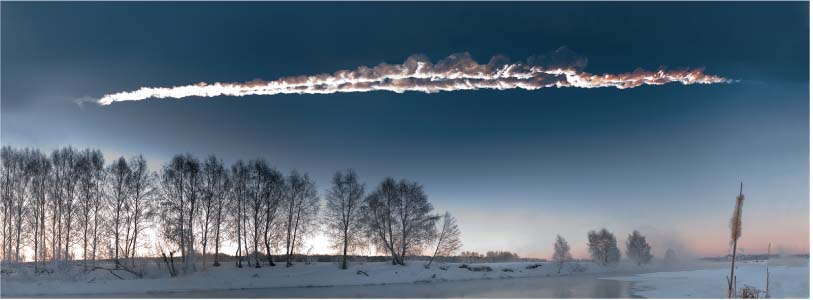
Marat Akhmetaleyev
Vapour trail of the Chelyabinsk meteor
The Chelyabinsk meteor passed over a relatively populated area just before it exploded, with the result that there are hundreds if not thousands of video clips showing the passage of the meteor and even the explosion itself. Perhaps the most famous account of the meteor is that of professional photographer Marat Akhmetaleyev, who had just set up his tripod to take some landscape photographs when the meteor came into sight, almost exactly in the frame where his camera was pointing. Despite the shock of the awesome spectacle, he managed to take the above pictures of the meteor’s passage and subsequent explosion.
He told the Siberian Times:
‘When the flash was as bright as possible, I felt strong heat in my face and strong pain in my eyes of intolerable glare. It lasted just a split second. My thoughts were confused and spontaneous. The first thing I thought was not a meteorite, but a nuclear bomb. Then I remembered the media reports about a possible asteroid and its approach to the Earth. Then there was the idea that a plane had crashed.’
Around two minutes after the flash, Mr Akhmetaleyev said he heard a series of ‘clear and powerful’ blasts as the meteor exploded with the force of 30 small nuclear bombs.
The meteor exploded at a height of approximately 23km, some 80km from Chelyabinsk. Over 1,500 people received medical attention as a result of the explosion: they were injured not from pieces of the meteorite but rather from flying glass and debris caused by the shock wave. Over 7,000 properties in six towns and cities across the region were damaged by the shock wave. The damage was estimated at over $33 million and would have been much greater had the explosion taken place closer to Chelyabinsk.

Gallo Images/AFP/OLEG KARGOPOLOV
Some of the damage caused by the shock wave of the Chelyabinsk meteorite
Finding pieces of the meteorite was relatively straightforward as the ground was covered with snow and any pieces landing were easily spotted. In some cases the pieces left holes in ice-covered lakes, which were clearly visible; a 20m-diameter hole in one of the lakes gave away the resting place of the main mass of 570kg, which was recovered on 16 October 2013.
While the Chelyabinsk meteorite is, in its own right, clearly an exceptional event and possibly the largest meteorite to strike the Earth in the past 100 years, it is also an incredible coincidence that it occurred on the same day that an asteroid passed within 28,000km of the Earth. To put this in perspective, the asteroid passed closer to the Earth than the orbit of the Moon, which was 15 times further away. It also passed inside the ring of geosynchronous satellites that orbit the Earth at a distance of about 36,000km. The obvious assumption is that the two events are related, since the chance of two completely unrelated meteors passing so close to Earth at the same time is minuscule. According to scientists, however, it is an extraordinary coincidence: the two meteors came from completely different directions and could not be related. The Chelyabinsk meteor arrived from the east and travelled west; it could not be seen in advance, since it came in from the sunny side and was therefore not reflecting light. The asteroid came in from the ‘dark side’ and was travelling from south to north, approximately 16 hours after the Chelyabinsk meteor. It had been identified by scientists weeks in advance and even given a name/number – 2012GA14. This asteroid was between 50m and 100m in diameter and would have caused massive damage had it connected with the Earth. According to the reports, scientists were unconcerned as they ‘knew’ it would not hit Earth. It passed by harmlessly, just as they expected.

Gallo Images/Getty Images/The Asahi Shimbun
A hole in a lake caused by the main mass of the Chelyabinsk meteorite
Viacheslav Kalachev
Above left: Sample of a Chelyabinsk meteorite of 128.5g, showing its burnt crust Above right: Cut face of the same specimen
Many pieces of the Chelyabinsk meteorite have been found and are readily available for sale on a number of web sites. Due to the huge exposure in the media of this meteorite, the prices tend to be higher than normal for what has been classified as an ordinary chondrite of type LL5. The price may drop in years to come as more material is found and the supply eventually exceeds the demand.
On 13 October 1838, at approximately 09h30, a meteor exploded over the Koue Bokkeveld area in the Western Cape, and the event was witnessed by several local farmers living in the area at that time. It is a well documented fall and has been extensively described in technical papers and newspapers. Various pieces of the meteorite were recovered from the area and now reside in museums around the world, including the Iziko South African Museum in Cape Town, Natural History Museum in London, the Scottish Museum in Edinburgh and the Austrian Museum in Vienna.
The Koue Bokkeveld meteorite is a rare carbonaceous chondrite and was one of the first of this type ever recovered. It is similar to the 1968 Murchison meteorite that fell in Australia, which contains various amino acids. Scientists believe that a similar meteorite falling to Earth millions of years ago could have introduced chemicals that seeded life on Earth.
The first account of the fall was provided by a circuit judge by the name of Mr Justice Menzies, who was in the general area of the fall and was accompanied by his colleague Mr George Thompson. Both of them were startled by the fiery rush of the meteorite, which they observed, and the loud detonation. They proceeded to the home of a local farmer, Mr Pieter du Toit, who provided them with a more detailed account of the explosion and subsequent fall of many meteorites. On their return to Cape Town, both were interviewed by Sir Thomas Maclear, who was His Majesty’s astronomer in the Cape, and their account was subsequently documented in various journals. According to reports, the exploding meteor was witnessed by only six people, all of whom provided detailed accounts.

Courtesy Ceres Museum
Koue Bokkeveld strewn field

A carbonaceous chondrite, 80g, recovered from the Koue Bokkeveld strewn field
The records show that more than 100 stones were recovered, some of which found their way to museums around the world, while others have never been documented and their current location remains unknown. It is clear, however, that only a fraction of the meteorites that landed was ever recovered, and the question remains as to whether any pieces are still lying around, waiting to be found. Unfortunately, this is unlikely to be the case with this rare and valuable carbonaceous chondrite. It is very soft and falls apart easily, especially if exposed to rain and sun – both of which are the norm in the strewn field. While it is highly unlikely that any pieces of the meteorite have survived the elements over the past 180 years, those living in the area should still be on the look-out for any unusual rocks resembling a charcoal briquette, such as that shown above.

Approximate location of the Gibeon strewn field
Gibeon meteorites are among the most popular and readily available iron meteorites in the world and the strewn field is possibly the largest known such field, although its exact extent has not been determined. It appears to extend from Keetmanshoop in the south to Mariental in the north, and is over 400km long by about 250km wide. It encompasses Gibeon as well as several other small towns, as shown in the above map, which provides a very rough indication of the likely strewn field.
The Gibeon irons were first officially recognised as meteorites in 1839 by Sir John Herschel, who analysed a fragment presented to him by Captain JE Alexander. Captain Alexander is famous for his expeditions into the former German colony, known as South West Africa, which was placed under the administration of South Africa following the end of the First World War in 1919. This arrangement continued until 1990, when South West Africa gained its independence and was renamed Namibia. A full account of Captain Alexander’s expedition of 1836–1837 is provided in his diary of the trip, published by the Royal Geographical Society (1838). During one of his visits to the area, he encountered several large masses of ‘native iron’, which were found on the surface in the Gibeon strewn field. In his journal he writes:
‘July 25 1837 – Crossed the Heineip or Thick Bush River. Here we saw iron occurring in veins on the side of a hill. There is also said to be to the North East of Bethany, near the Great Fish River, a plain covered with large masses of iron, some of which require several men to lift them. I have got specimens of this iron.’

Some of the large Gibeon meteorites on display in Windhoek
The specimens were presented to Sir John Herschel on his return to Cape Town in 1838 and were subsequently identified as meteorites. Fragments of the iron meteorites had long been used by the Nama natives for making spear heads and other weapons by hammering the ductile iron-nickel metal into various shapes. The Gibeon meteorites have a nickel content of approximately 8% and the metal alloy is very ductile, with relatively few other impurities or inclusions. As a result, it tends not to rust easily and is one of the most stable iron meteorites known.
Many large masses of the Gibeon meteorite were found and transported to museums and universities around the world in the early 1900s. Pieces of over 500kg are not uncommon, and the largest piece of 680kg was donated to the Iziko South African Museum in Cape Town, where it can be viewed today.
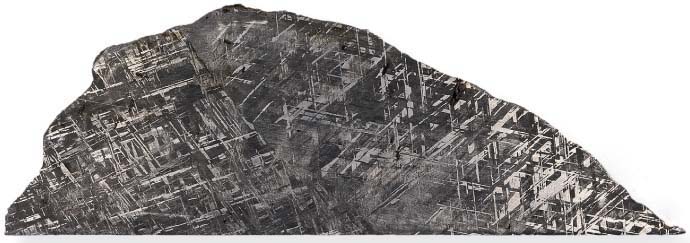
Bruce Cairncross
Widmanstatten lines on Gibeon iron meteorite; 250mm long
In 1913, Dr Paul Range, the government geologist in South West Africa, collected 37 specimens from the area first described by Captain JE Alexander, with a combined weight of over 12t, many of which now reside in the main meteorite display in Windhoek – as shown opposite.
There are many tons of Gibeon meteorite in general circulation throughout the world and specimens can be seen in virtually every large collection; it is simply one of the ‘must-have’ iron meteorites because of its durability and resistance to rust, as well as the stunning and varied shapes that it exhibits. In addition, the Widmanstatten lines tend to be clear and crisp which, with its resistance to rusting and its malleability, makes the Gibeon the meteorite of choice for jewellers wishing to create ‘space jewellery’ without having to spend a fortune on one of the stable pallasite meteorites.

Close-up of Widmanstatten lines on a Gibeon meteorite

Bruce Cairncross
Gibeon ‘cosmic hole’ of 9kg; 170mm × 250mm

Bruce Cairncross
Unusual oriented 12kg Gibeon meteorite; 220mm × 220mm; virtually flat at the back, it has a rough cone shape at the front with unusual flow paths on the surface

Bruce Cairncross
A ‘family’ of Gibeon meteorites
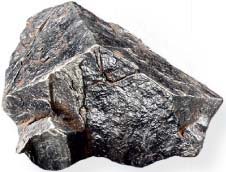
Bruce Cairncross
Gibeon ‘crystal’ of 240g; 60mm × 35mm – quite rare and highly sought after by collectors

Bruce Cairncross
Unusually shaped 7kg Gibeon meteorite; 220mm × 180mm

Bruce Cairncross
Interestingly sculpted Gibeon meteorite; 2,200g

Bruce Cairncross
Etched Gibeon sphere; 80mm diameter, showing the crisp 3-D effect of the Widmanstatten lines
Gibeon meteorites are found in a wide variety of shapes and sizes and, when they have holes and other strange formations, sometimes resemble artistic sculptures, as shown in images opposite and above. Meteorites with holes are not common and command a premium, as do other interesting and unusual shapes. Sometimes they exhibit signs of orientation, with unusual flow paths on the surface. Occasionally, meteorites weather along the crystal planes, and pieces are found that exhibit a clear crystal shape. Such ‘crystals’ are quite rare and highly sought after by collectors.
Bull’s-eye on Barberton?
Scientists have recently raised the idea of an impact – near Barberton in Mpumalanga – of a gigantic meteorite that arrived much earlier and was significantly larger than the one that killed the dinosaurs 65 million years ago. The geology in the Barbeton area points to such an event. Estimated to have been up to 58km across, the meteorite could have been one of dozens of huge asteroids that scientists think hit the Earth during the Late Heavy Bombardment period, a major period of impacts that occurred early in the Earth’s history, around 3–4 billion years ago. It would have left a crater nearly 500km wide and possibly changed the very nature of the tectonic plates on which the surface world floats. The impact would have devastated the surface environment: the resulting 10.8-magnitude earthquake would have generated tsunamis thousands of metres high; the sky would have become red hot, the atmosphere been filled with dust and the ocean surface would have boiled. It may have wiped out many microscopic organisms living on the developing planet – which would have created niches in which new organisms could evolve.

Emilio Vilaro
The Hoba meteorite in Namibia – the largest known meteorite in the world

Location of the Hoba meteorite in Namibia
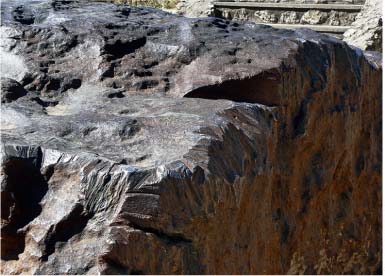
Emilio Vilaro
Close-up of the Hoba meteorite showing signs of vandalism

Emilio Vilaro
Section of the Hoba meteorite removed in 1958, with official permission, by the Tsumeb Mining Corporation
The Hoba is an iron meteorite weighing almost 60t and is 3m long by 3m wide and approximately 1m thick, making it the largest single meteorite known on Earth and consequently one of the most famous. It is located near Grootfontein in Namibia. It was discovered by Jacobus Britz in 1920 on his farm and was declared a national monument on 15 March 1955. The meteorite has barely rusted thanks to the dry desert climate and the fact that it is nickel rich. The meteorite is composed of approximately 82% iron and 16% nickel, with the remainder being made up of cobalt (around 0.7%) and various trace elements including carbon, sulphur, chromium, copper, zinc, gallium, germanium and iridium. Such meteorites are called ‘ataxites’ and do not exhibit any Widmanstatten lines.
According to scientific calculations (McCorkell & D’Amico, 1966), the Hoba meteorite is thought to have crashed to Earth between 80,000 and 300,000 years ago, based on the isotope measurements of the iron and cobalt within it. It is located in an area of white calcrete overlain by Kalahari sands that fill the valley floors between ridges of folded dolomite, which rise to form the Otavi Mountains to the west of the meteorite. This area forms the edge of the extensive Kalahari plain that stretches towards the east and southeast.
Although this meteorite is the largest in the world, there are very few fragments or samples in private collections as it is a national monument and it is illegal to cut or damage the specimen. Despite this, various attempts have been made, using hacksaws and gas cutting equipment, to remove samples of it. In most cases only small fragments were recovered. The Namibian government takes strong exception to anyone damaging the Hoba and will prosecute anyone found doing so. Some pieces were taken legally for analysis purposes back in the early and mid-1900s before the meteorite was declared a national monument.
In 1958 a team from Tsumeb Mining Corporation was dispatched to recover a piece for scientific purposes with permission from the Namibian government. A core drilling machine from the mine was used and a section of the meteorite was eventually removed and taken back to the mine to be cut into slices. The exercise took almost three weeks to complete: the cores had to be drilled very slowly because of the absence of local water, which would normally be used as a coolant in such operations. The scars on the meteorite from some of the old cut marks, both legal and illegal, can still be seen. Slices from the 1958 sample now reside in museums throughout the world, and may account for some of the following specimens:
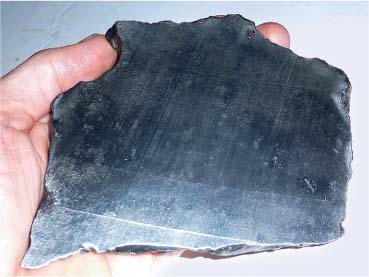
A rare slice of Hoba meteorite, 570g

Document atesting to Eric Louw’s ownership of a 570g-slice of the Hoba meteorite, inherited from his grandfather Herbert Poonanski who was part of the team that recovered a piece of the stone for scientific purposes in 1958

Location of Korra Korrabes farm
While searching for Gibeon iron meteorites in southern Namibia in the early 1990s, a local meteorite hunter found a relatively large amount of ‘crust’ material in the vicinity of the farm Korra Korrabes, just south of Mariental.
Material such as this, which resembles hematite or magnetite, is often found on the surface of the ground directly above large Gibeon meteorites located up to a metre or two below the surface. This crust material is the indicator that local farmers and sheep herders look for when they are searching for iron meteorites in the Gibeon strewn field. In this instance, the crust material was slightly different and there was no Gibeon meteorite to be found anywhere nearby. The material was sent to Windhoek, where it was abandoned in a garden for several years, with the largest piece being cemented into a garden wall as a novelty. It remained here for many years, undetected as part of a meteorite. It was not until many years later, in August 2000, that one of the pieces was retrieved and cut up by the author, who then proposed that the material could be a meteorite. The material was sent to Prof. Lewis Ashwal, then at the former Rand Afrikaans University, and was eventually identified as a stone meteorite of type H3, which is one of the less common high-iron stone meteorites. Prof. Ashwal and his team have undertaken considerable studies of the Korra Korrabes meteorite (Ashwal, 2001) and have concluded that it is an H3 chondrite. The meteorite was named ‘Korra Korrabes’ after the farm on which it was found.
Approximately 40kg of the Korra Korrabes meteorite was initially recovered, including the main mass of 24kg, which was recovered from the garden wall in Windhoek. This piece was eventually cut into three portions, the largest of which was donated to the Namibian Heritage Council, together with many of the smaller fragments, for research purposes.
From the outside, this is a particularly ugly and nondescript meteorite and would not be identifiable by many a respected meteorite hunter. It looks like a normal garden rock, has no fusion crust, no regmaglypts, no flow lines – basically, none of the visual features that one looks for when searching for meteorites. It is, however, strongly attracted to a magnet, in much in the same way as a magnetite nodule is.
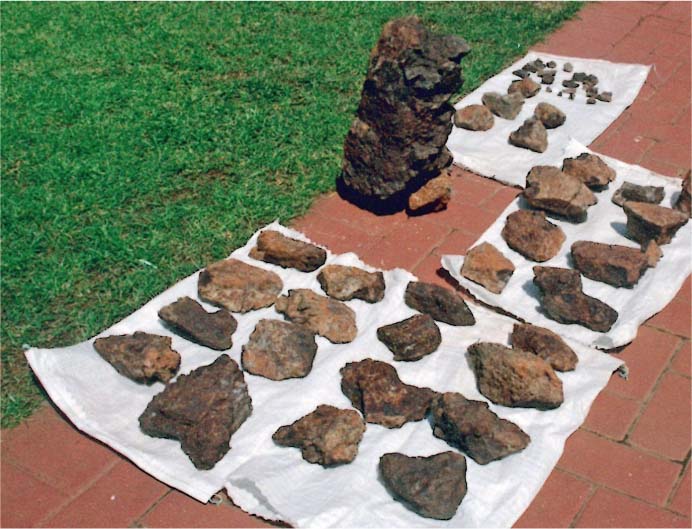
Original recovered material from Korra Korrabes

Rock garden wall where the Korra Korrabes meteorite was found
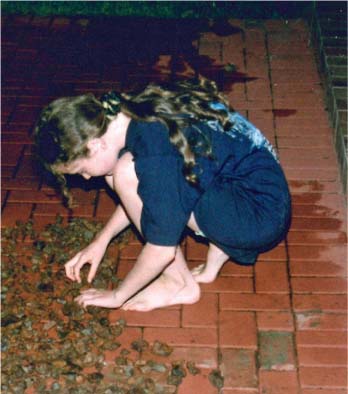
Sorting small fragments of Korra Korrabes

Main mass of Korra Korrabes recovered from garden wall
Following the initial discovery, local residents returned to the farm to try and find more material. According to reports from the locals, a further 90kg of highly weathered material and about 10kg of what may be a different meteorite were found, bringing the total recovered material to approximately 130kg. Of this, 40kg was solid compact material, with the balance being very weathered and highly porous material, as well as over 1,000 small pieces of good-quality solid material. Most of the poor-quality, porous material has since been given away to school children or at various presentations and discussions on meteorites.
IMCA
The International Meteorite Collectors Association (IMCA) is an excellent source of information about meteorites. Its aim is to educate people on the topic and to help collectors in their search for authentic stones. Anyone who has an official IMCA number is recognised as a credible meteorite collector/dealer by collectors worldwide. (The author is the only member from South Africa.) Look out for the insignia of the IMCA, and visit the association’s website for more information (www.imca.cc).

Close-up of a slice of Korra Korrabes meteorite showing iron-nickel
The Korra Korrabes meteorite specimens tend to be very dense, do not rust easily and are dark in colour when polished. The chondrules are clearly visible and, because it’s an H-type chondrite, it is strongly attracted to a magnet. Some pieces have quite large nuggets of iron-nickel, which are clearly visible when the stone is cut and polished. Many of the larger pieces exhibit irregular fractures several centimetres into the specimen, which are probably caused by the extreme temperatures experienced in the Korra Korrabes area.

Site of the Muonionalusta meteorite
The Muonionalusta meteorite was first described by A Högbom in 1910, shortly after the first specimen was found by Viktor and Amalia Mattila in northern Sweden.
A second meteorite was found in 1946 and a third in 1963, after which a paper was published in 1963 by Frans Wickman, who suggested that there could be many more in the area.

Thomas Oosterberg
Swedish meteorite hunter Thomas Oosterberg, who led expeditions in search of Muonionalusta meteorites

Thomas Oosterberg
Discovery of a Muonionalusta meteorite buried 3m underground
Around 1990, a fourth meteorite was found some 10km west of Muonionalusta during the processing of gravel (Svensson, 2006). It was not until 10 years later that a group of Swedish meteorite enthusiasts decided to search for more meteorites, and in 2001 the first expedition left for Muonionalusta, equipped with modern metal detectors. This initial investigation was unsuccessful, as was a second expedition, in 2002, led by Thomas Oosterberg, a Swedish meteorite collector. In 2003, however, Oosterberg was successful, finding several small specimens. The following year he was joined by a friend, Daniel Svensson, and together they found several meteorites ranging from 1kg up to 78kg. As a result of their efforts, word soon circulated to other meteorite hunters, leading to the recovery of many tons of new specimens. The result is that Muonionalusta is now virtually as common as the Gibeon, if not more so.
The meteorites are found in an area of deep and often boggy soil that contains rocks and boulders brought down by the glaciers. The meteorites must have landed during summer as the ground is frozen during winter, when the meteorites could not have penetrated to the depths of between 1m and 4m at which they have been found.
The iron meteorites tend to be highly weathered due to the damp conditions in which they have existed for so many years. As a result, they often have a thick layer of rust that can be difficult to remove completely, and some specimens have cracks, allowing moisture to penetrate deep into the meteorite, which in turn creates rust many centimetres into the core of the specimen.

Muonionalusta showing Widmanstatten lines and crack; 38kg
When cut, the Muonionalusta meteorite is very similar to the Gibeon and has a sharp and clear Widmanstatten pattern.
The specimens tend to be rather round and lumpy, as can be seen in the image below. They rarely exhibit the characteristic hollows and regmaglypts found in some other iron meteorites, such as the Gibeons. They do, however, etch very easily and, unlike the Gibeon, there are virtually no specimens that do not take an excellent etch. The Muonionalusta meteorites sometimes contain large nuggets of troilite and graphite (see image on opposite page), as well as small nodules of extremely hard material that makes cutting difficult – the nodules can strip saw blades that are not specially diamond crusted.
Weathered specimens tend to rust easily, while others that have clearly not been subjected to damp conditions can be very stable and are similar to the Gibeon in their resistance to rusting.
Prior to the efforts of Oosterberg and his friends, the Muonionalusta meteorite was very scarce and thus expensive. It was rarely, if ever, available for sale at mineral shows prior to about 2002.

A typical Muonionalusta meteorite of 37kg
Today, the Muonionalusta meteorite is a common sight at meteorite shows and is also available for sale on many web sites. The price of high-quality specimens dropped to well below the price of Gibeons at one stage, but has since recovered to some extent as the supply of new Muonionalusta meteorites has also dwindled in recent years. The meteorite is popularly used in watch faces and other such applications, thanks to the very crisp pattern that can be obtained when it’s etched properly, and it has effectively replaced the Gibeon as the meteorite of choice for many jewellery applications – partly thanks to the crisp Widmanstatten lines, but largely to its availability and the fact that Gibeon meteorites have become relatively scarce and expensive in the past decade.

Location of the Murchison meteorite
The Murchison meteorite is, without doubt, one of the most significant meteorites ever recovered. It fell at 10h50 on 28 September 1969, over the small town of Murchison in Victoria, Australia.
Some 700 individual stones were recovered, with a total weight of approximately 100kg. It is a rare carbonaceous chondrite, and was witnessed by many of the residents living in Murchison, who quickly recovered specimens. According to many reports, the meteorites had a very strong smell, similar to alcohol or methylated spirits – a smell that filled the air soon after the fall. Many of the specimens recovered are pristine and exhibit perfect black fusion crusts, often with flow lines and clear lipping. Some specimens are clearly oriented, often with excellent regmaglypts. One of the best Murchison meteorites recovered, almost 1kg in weight, has no chips or damage from its fall and has a perfectly formed fusion crust over the whole specimen (see image on page 105).
The events of the fall are described in the witnessed report by Mr D Patterson, a resident of Murchison:
‘On Sunday the 28th of September 1969 at 10h50 am, a meteorite fell in the cow yard of a dairy on the outskirts of the town of Murchison. At the time my wife and I were getting ready to go out when we heard a rumbling noise and then a bang. When we looked outside, the cattle in the paddock behind the house were all racing about, as were a couple of horses further over. We were puzzled as to what had caused this loud noise for there was a cloudless sky. Neighbours and friends were discussing the loud noise and its cause later that day. A few days later I was out at my farm at Murchison East irrigating the pastures when I noticed a lump of black material on the ground which I thought was most unusual so I picked it up and brought it home. This lump of rock had a very strong smell similar to methylated spirits. By this time it had been confirmed that a meteorite had fallen on the other side of the Goulburn River.’
Over the past 40 years or so, many researchers have investigated the Murchison meteorite and it has become one of the most important meteorites ever recovered due to the unusual organic materials identified in it. Specimens recovered contained not only alcohol, but also up to 12% by weight of water. Many other interesting and unusual organic compounds have also been identified, including numerous ‘left-handed’ amino acids, carboxylic acids, fatty acids, sugars and nucleotides, which are of great interest to scientists. Living organisms utilise these organic compounds to form proteins and DNA, which are key ingredients for all life on Earth. Following the scientific analysis of the Murchison meteorite, it is now considered possible that the delivery of organic compounds by meteorites or even dust particles from comets etc., may have contributed to the appearance of life on Earth. The significance of the Murchison meteorite is summed up nicely by G Shanos (2010), in which he concludes:
‘Thirty years after its arrival, the Murchison meteorite continues to astound the scientific community with new and exciting discoveries from the interstellar to the origins of life on Earth. The four types of carbon (graphite, diamond, fullerene and organic) found in meteorites continue to rewrite textbooks as research in this area is ongoing.’

Meteorite found by Murchison resident Mr Patterson; 532g
Why are some meteorites attracted to a magnet and others not?
Most meteorites contain sufficient iron to be attracted to a magnet. However, some of the rarer meteorites contain virtually no iron and are therefore not attracted to a magnet at all, making them harder to identify. Examples of meteorites that are not attracted to a magnet are those from the Moon and Mars.
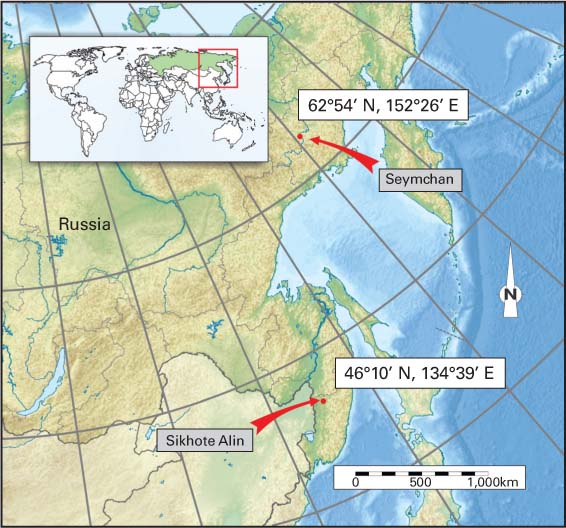
Map showing two of the famous Russian falls
Another noteworthy meteorite is the Seymchan from northeast Russia – currently one of the most popular meteorites with new and seasoned collectors alike. It is found as an all-iron octahedrite meteorite with stunning Widmanstatten lines and it is also found as a pallasite.
Initially Seymchan meteorites were regarded as the poor relations of the pallasite community, due to the poor quality of the olivine crystals, which tend to be opaque and brown in colour. In recent years, however, the Seymchan pallasites have been elevated in status as some very attractive specimens are finding their way onto the market. Although Seymchan may not be in the same league as the Esquel and Imilac pallasites, some of the more recent specimens are approaching the high end with regard to quality.
Fortunately, the price of a good Seymchan meteorite has yet to increase to levels similar to those of the Esquel and Imilac, with the result that they often represent the best value for money of all pallasite meteorites. The Seymchan meteorites have proved over the years to be very stable and rarely show signs of rust. With high-quality pallasite available at very reasonable prices, one or two of the Russian dealers have even started offering pallasite spheres made from the Seymchan – something that was never possible with the Esquel and Imilac as a result of the high price. The resulting Seymchan spheres are often stunning and very popular with both collectors and non-collectors.

Bruce Cairncross
Etched slice of Seymchan pallasite of 4,060g; 360mm × 250mm

Bruce Cairncross
Seymchan pallasite sphere of 843g; 62mm diameter

Bruce Cairncross
Seymchan pallasite with dark opaque peridot; 400g

Bruce Cairncross
Seymchan sphere of 837g, showing Widmanstatten lines; 60mm diameter

Viacheslav Kalachev
Hunting for Seymchan meteorites

Viacheslav Kalachev
World’s largest pallasite sphere at almost 12kg and 170mm diameter
On a clear, cold morning on 12 February 1947, a spectacular fireball passed over eastern Russia between Vladivostok and Khabarovsk, and exploded at around 10h38 local time. The fireball was observed by many residents living in the area, as well as by an artist who painted a picture of the unusual sight. The fireball crossed the sky from north to south, leaving a trail of burned-out meteorite particles resembling thick smoke. The fireball was observed to break up into several parts before it passed out of sight as it moved over the Sikhote Alin Mountains. The whole event took about 4 to 5 seconds and, after some minutes, the local inhabitants heard several loud explosions that were followed shortly by a rumbling noise similar to distant thunder.
Many of the witnesses living in villages situated along the path of the meteor reported strange phenomena, such as doors blowing open, windows rattling or breaking, plaster falling from walls and ceilings, and flames shooting out of fireplaces as the meteor passed overhead, or shortly after, as the pressure wave from the explosions swept through.
Witnesses from an area of up to more than 600km from the eventual point of impact confirmed that the event was all over within the space of a few seconds. The trail of dust and smoke in the atmosphere remained visible for the remainder of the day and gradually twisted and turned in the normal air currents in the upper atmosphere.

AA Medvedev
A painting of the Sikhote Alin meteorite fall by AA Medvedev
An artist, named Medvedev, was busy painting a landscape when the meteor came into view, and adapted his painting accordingly; it was used in the famous postage stamp 10 years later, in 1957. It is one of the Russian postal service’s most popular stamps, particularly among meteorite collectors worldwide.
Within two days, the location of the fall had been identified by pilots who had flown over the area and had observed craters in the fresh snow. Shortly thereafter, Russian scientists visited the area and confirmed what is today regarded as the largest fall of iron meteorites in modern times.
Expeditions to the area immediately after the fall resulted in the recovery of many tons of specimens, most of which were very fresh with pristine fusion crust and no rust. This is also one of the very few falls in the past 100 years that have created craters, as most meteors tend to break up completely in the atmosphere and fall under gravity rather than travel at great speed towards the Earth’s surface.

Bruce Cairncross
Unusually oriented Sikhote Alin meteorite of 135g; 40mm × 50mm
The Sikhote Alin meteorite fall is classic for a number of reasons, and a specimen from here is essential for any meteorite collection. The fall is interesting not only because it created craters but also because some pieces landed on Earth as beautiful crusted specimens with regmaglypts, while others have the appearance of shrapnel from a military shell. There are also large specimens, which can be several hundred kilograms in mass, and there are many thousands of small specimens that also have beautiful fusion crust and are completely covered in regmaglypts – dispelling the misconception that regmaglypts occur on large specimens only. Another feature of the Sikhote Alin fall is the large number of small, beautifully oriented specimens that exhibit stunning and unusual features of oriented meteorites, from perfect cone shapes to lipping and flow lines. Two more unusually oriented Sikhote Alin meteorites (right and opposite, top) clearly show why the Sikhote Alin is a favourite with any collector.
The Sikhote Alin strewn field has been fully investigated and mapped in great detail to identify the position of all craters and the locations of most of the medium to large meteorites recovered. The meteor exploded close to the ground at an estimated height of only 3.5km, which is unusually low down. As a result, the main strewn field, which was heavily cratered, was very small – only about 1.2km long by about 500m wide.
There were multiple explosions, however, with some being higher above the ground. There appears to be a secondary strewn field, which is larger than the main strewn field and is estimated to be around 12km long by 4km wide, which is still very small for such a large event. This can be compared to the Gibeon strewn field, which is estimated to be more than 300km long by over 200km wide. Twenty-four major craters of over 9m in diameter have been identified, in addition to more than 98 smaller craters, which have depths of between 0.5m and 9m. The largest crater was 26m in diameter and 6m deep. The largest specimen recovered was 1,745kg, which was excavated from a crater of only 3.5m in diameter at a depth of almost 4m. This stunning specimen is oriented with distinct flow lines and regmaglypts and is on permanent display at the Fersman Mineralogical Museum in Moscow. Although the official estimate of recovered meteorites is only 23t, it seems likely that the true figure is between 50t and 100t, based on discussions with various Russian meteorite dealers and collectors who have indicated that there is already more than 27t stored at the Vernadsky Institute.
How many craters are known on Earth?
Due to the protection provided by the atmosphere there are relatively few meteorite craters on Earth, probably about 150 verified ones, including the massive Vredefort Dome, some 100km southwest of Johannesburg in South Africa. Although this crater appears to be about 90km in diameter on the surface, the base rock impacted by the meteorite strike has been altered over an area of more than 300km in diameter and is currently the largest known meteorite impact structure on Earth.

Bruce Cairncross
Unusually oriented Sikhote Alin meteorite of 88g; 77mm × 33mm
The Sikhote Alin meteorite is classified as an octahedrite with a nickel content of around 6% and 93% iron. It includes traces of cobalt, copper, phosphorus and silicon, which are found in the minerals kamacite, taenite, troilite, schreibersite and chromite. Next to the Gibeon meteorite, the Sikhote Alin is one of the most common iron meteorites and is readily available to collectors.
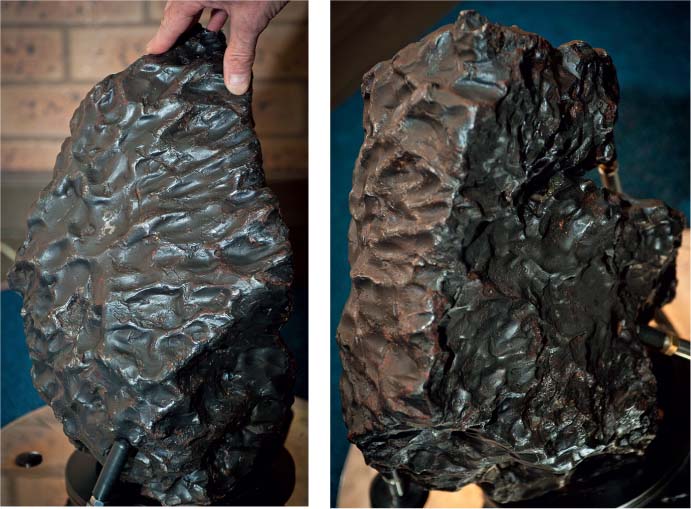
Above left: A cone-shaped Sikhote Alin meteorite of approximately 80kg, which is crusted with clear regmaglypts Above right: The back of the meteorite is completely different: it is almost flat, with no regmaglypts. This is typical of cone-shaped meteorites, where the rear side often shows cavitation created by the negative pressures present in the fall.

Location of Lesotho relative to South Africa
On 21 July 2002 at 15h48 South African Standard Time (13h48 GMT) the Thuathe meteorite fell in southern Lesotho. It was witnessed by many hundreds, if not thousands throughout South Africa and Lesotho, who supplied reliable eyewitness reports of the event, and remains the only officially recorded meteorite fall in Lesotho. Many samples of the meteorite have since been recovered and it has been classified as an ordinary chondrite of type H4 by Ambrose & Talukdar (2003).
Lesotho is a small, picturesque, mountainous kingdom located in the middle of South Africa, which totally surrounds it. Maseru, with a population of approximately 250,000, is the capital, while Thuathe, where the meteorite was found, is the name given to a flat plateau (also known as the Berea plateau) some 5km east of the capital.
The Thuathe strewn field is a picturesque valley located at an elevation of about 1,600m, surrounded on two sides by a higher plateau at an elevation of approximately 1,850m. It is a relatively small strewn field, about 8km in length by about 4km wide. The strewn field includes both comparatively flat areas on the valley floor as well as on the Thuathe plateau, together with steep rocky areas on the sandstone escarpment. Small villages are scattered throughout the area on both the plateau and beneath the cliffs of the escarpment.
Unlike most of the surrounding countryside in South Africa, Lesotho is located in a relatively high-rainfall region, experiencing more than 1,000mm of rainfall per annum. It also experiences frost and snow during much of the winter period, and the six-month period immediately after the fall was particularly wet, with unusually heavy rain (almost four times the average) during August and September. As a result, some of the samples recovered towards the latter part of the period show more severe weathering and oxidation than would normally be expected for such a fresh fall.

Location of the Thuathe plateau

Thuathe strewn field as seen from the Thuathe plateau

Local resident with Thuathe meteorite for sale
The initial recovery team was headed by Prof. David Ambrose, who was living in Lesotho at the time and was able to collect the bulk of the specimens. He meticulously examined and recorded each specimen, together with any details available of its recovery. In this manner, he was able to compile a catalogue of recovered stones (Ambrose & Talukdar, 2003) and at the same time develop an accurate map of the strewn field. Ambrose’s catalogue is one of the most comprehensive records of any meteorite fall.
The total weight of the fall is now estimated (by Prof. Ambrose), to be in the order of 100kg, of which approximately 70kg (representing almost 1,600 individual specimens) have been examined and catalogued by Ambrose. There are nine villages in the strewn field and, while the local meteorite hunters appreciate that you can never find all the stones, the local residents have now scoured the area for more than 10 years and very few new stones have been recovered since 2006.
It should be noted that the legislation regarding the ownership of meteorites in Lesotho was changed in 2013 and it is now illegal for anyone to export a meteorite from Lesotho into neighbouring South Africa – or any other country, for that matter. This will discourage any further searching for meteorites in Lesotho and have the effect of pushing up the price of any meteorites already exported legally from Lesotho before the new law came into effect.
The Thuathe meteorite is an H4 chondrite, based on the research undertaken by Prof. Lewis Ashwal from Wits University in Johannesburg. The classification is fully described in various papers by Ambrose & Talukdar (2003) and McKenzie (2003)
Possibly one of the most interesting aspects of the Thuathe meteorite is the variation of stones found in the strewn field. Some stones, for example, exhibit a full thick black fusion crust that shows no signs of weathering or oxidation, while others exhibit a combination of thick and thin fusion crusts on different faces, indicating that they experienced shattering and subsequent re-melting during their passage through the atmosphere. The surfaces of some stones suggest they have undergone several stages of breaking and fusing during their trip to Earth.
Details of many interesting, and sometimes humorous, accounts are documented in the two papers written by the recovery teams, which independently identified the location of the fall.
One of the more interesting and unusual eyewitness reports came from Captain Jane Trembath, an airline pilot with South African Airways, who was travelling towards the south at 35,000 feet when she saw the meteorite and the associated vapour/smoke trail. According to Captain Trembath:
‘I was flying from Johannesburg to Port Elizabeth on the afternoon of 21 July 2002 in a Boeing 737-200. We were still climbing to our cruising level of 35000 ft and I happened to be gazing out front when I saw a downwards vertical very bright pale orange streak. It was followed shortly by a spectacular pale orange explosion and was certainly the most impressive event I have seen in the sky and being daytime made it even more amazing. I took aviation charts and plotted my estimate of the position that the event happened, and my estimate put the position at about halfway between Ficksburg and Maseru, just inside Lesotho.’

Bruce Cairncross
Fine example of an oriented Thuathe of 450g; 90mm × 63mm
Evident in one particular Thuathe stone (shown on page 116) are crack lines. Although Prof. Ambrose attributed the cracks in this specific stone to the owner’s attempts to break it, it has subsequently been established that the cracks are due to the stresses experienced by the stone on its passage through the atmosphere, as well as the impact with the ground on landing. Such cracks are often found in stone meteorites and the stones tend to break along the cracks to give almost flat surfaces. Several pieces of the Thuathe meteorite were found that had broken along such cracks and, in some cases, the start of a new fusion crust was evident on the fresh white flat surface, indicating that it had broken during the flight to Earth and not subsequent to its arrival.

Bruce Cairncross
Above left: Nicely crusted Thuathe of 1,180g; 130mm × 80mm; recovered by Prof. Willem van der Westhuizen from the University of the Free State shortly after the fall. It exhibits typical regmaglypts and has a thick, jet-black fusion crust. Above right: Thuathe of 2,387g; 140mm × 130mm – the largest specimen recovered during the first year and named ‘the Bear’ by Prof. Ambrose who purchased it from one of the locals. It is one of the most attractive large meteorites yet recovered from the area.
It is interesting to note that the Thuathe meteorite fell on the same day as another witnessed fall in Nigeria (a completely different type of meteorite), more than 5,000km to the north and west of Lesotho – coincidental and entirely unrelated incidents.
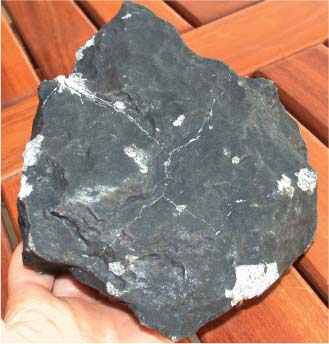
Thuathe of 2,421g, showing crack lines; 150mm × 160mm – one of the largest meteorites to be recovered from this site

Location map of the Tissint meteorite
As reported by Abderrahmane Ibhi (2012) and Aoudjebane et al (2012), a meteor exploded in the vicinity of Tata (Morocco) on 18 July 2011 at about 2h00. The event was witnessed by several nomads living in the Oued Draa valley southeast of Tata who claimed to have seen a yellow light that gradually turned green, lighting up all of the Oued area, and to have heard two sonic booms. Nomads immediately started searching for stones and about three months later, in October 2011, started to find fresh and shiny, fusion-crusted meteorites in an area close to Tissint in the El Aglab region of Morocco, approximately 60km southeast of Tata towards the border with Algeria.
Over the next year, many hundreds of local residents searched the strewn field for meteorites. The strewn field is remote – about 60km by dusty road from the nearest village in the El Aglab Mountains, close to the Algerian border, which presents its own hazards. The name Tissint, the name of the nearest village, was chosen by Aoudjebane. The strewn field is estimated to be about 4km long and it is thought that recovered meteorites amount to over 20kg. Pieces of the new Tissint meteorite range in size from less than 1g to the largest piece, reported to be over 2kg. What makes the Tissint meteorite worthy of special mention is the fact that it has been classified as a Martian shergottite meteorite and is the first of its type to be a witnessed fall in Morocco.
By the beginning of 2012, over 15kg had been recovered and the stones are reported (Ibhi, 2012) to have changed hands at extremely high prices. At the time of writing this book, it was available on various internet sites close to the $1,000/g mark, placing it in the small group of elite meteorites for sale at this price.
The Tissint meteorite is a typical shergottite, and similar to several other meteorites that originate from Mars. It is, however, most unusual to find such well preserved and, in many cases, pristine, fully crusted stones from Mars. According to Ibhi, there were at least five large, fully crusted stones of more than 500g and a further 11 smaller stones of between 100g and 500g – most of which were also fully crusted. One of the larger stones of 298g is shown alongside, from which it can be seen that the crust is completely intact and has a jet-black, shiny surface.
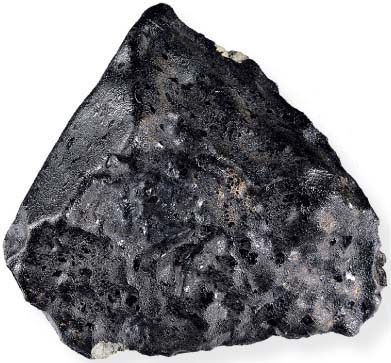
Bruce Cairncross
Tissint of 298g, fully crusted; 78mm × 70mm
The total mass of the Tissint meteorite recovered to date is not known due to the fact that so many nomads were involved in the search. According to Adam Aaranson (one of the main meteorite dealers from Morocco) and others, there were several hundred local residents and nomads searching for stones during the initial hunt. The area has been well searched and it is seems unlikely that many more pieces from this highly significant fall will be recovered. It remains one of the most important meteorite falls in the past 100 years and offers some of the only pristine samples from Mars available on Earth.